
At Master’s Academy in Vero Beach, Florida, the volleyball program seeks to provide a competitive and successful opportunity that points players to Christ and builds the character of Christ within each student athlete.
One of several bills that would let charter school students play sports and participate in extra-curricular activities at willing private schools has cleared the Florida Legislature and awaits Gov. Ron DeSantis’s signature.
In a display of bipartisanship, all 116 of the House members who were present voted to approve SB 190, which was substituted for its companion, HB 225.
Both bills would allow charter school students to play on private school sports teams and participate in private school extra-curricular activities fi a private school agrees. Current law already allows homeschooled students to do this, and these bills would extend the same provisions to those who attend charter schools and Florida Virtual School.
The vote came nearly a month after the Florida Senate gave final approval in a 38-0 vote.
“We are just absolutely thrilled,” said Wayne Smith, head of school at Master’s Academy, a small private Christian school in Vero Beach that served as the inspiration for the bill. He said the outcome could be a good civics lesson for his students, who were demoralized when the Sunshine State Athletic Association disciplined the school for letting students at a nearby charter school to play on its varsity football team.
Under current law, if a specific program isn’t available at a charter school, the only option for those students is to sign up for it at their zoned district schools. The proposed legislation would let charter students choose between the district school and or a nearby private school through a special agreement.
However, the arrangement at Master’s Academy had been going on for years without controversy, based on an interpretation of the law that allowed the homeschoolers to play at private schools.
Last year, someone complained, and the Sunshine State Athletic Association forced the charter school students off the team in the middle of the season and stripped Master’s Academies of its victories up to that point.
Smith said the decision left the students heartbroken but motivated.
Members of school tennis and baseball teams stepped up to fill the vacancies on the football team. Despite the disciplinary action, the school ended up winning the championship.
News about the controversy got the attention of the community’s state senator. Sen. Erin Grall, a Republican whose district includes Vero Beach, responded by sponsoring SB 190.
“The parent makes the decision not to send their child to the public school they’re zoned for and instead chooses to send their child to a charter school,” she said during a committee meeting on the bill. “This lines up the homeschooling statute with the charter school statute … to fix it and make it more clear.”
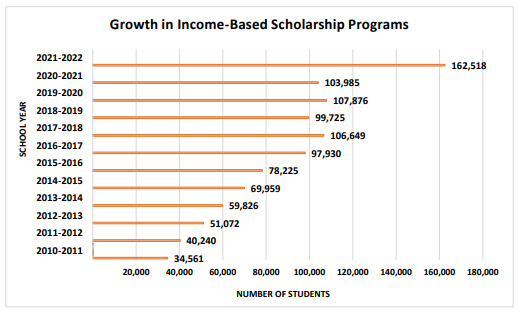 The number of Florida students participating in income-based scholarship programs served by Step Up For Students over the past 12 years has grown dramatically, from 34,561 in 2010-11, to 162,518 in 2021-22, according to a new report by Step Up For Students, the nonprofit scholarship funding organization that helps administer the scholarships and which hosts this blog.
The number of Florida students participating in income-based scholarship programs served by Step Up For Students over the past 12 years has grown dramatically, from 34,561 in 2010-11, to 162,518 in 2021-22, according to a new report by Step Up For Students, the nonprofit scholarship funding organization that helps administer the scholarships and which hosts this blog.
The largest increase in Step Up students occurred between 2020-21 and 2021-22, however this was due to Step Up taking over stewardship of enrollment numbers of the Family Empowerment Scholarship for Education Options (FES-EO), a program that had previously been administered by the Florida Department of Education. Statewide enrollment for income-based scholarships increased from 142,716 to 162,518 when all sources of enrollment are included.
In the most recent year, a total of $1,715,159,524 was awarded to families from Step Up.
The annual end-of-year report looked at characteristics of private schools and enrolled students who received a Florida Tax Credit Scholarship or a Family Empowerment Scholarship for Educational Options through Step Up For Students, examining the distribution of private schools by various attributes and calculating graduation rates for 12th grade scholarship students enrolled in these schools.
Additionally, the report analyzed student demographics both in overall program enrollment and graduation rates.
Among the findings:
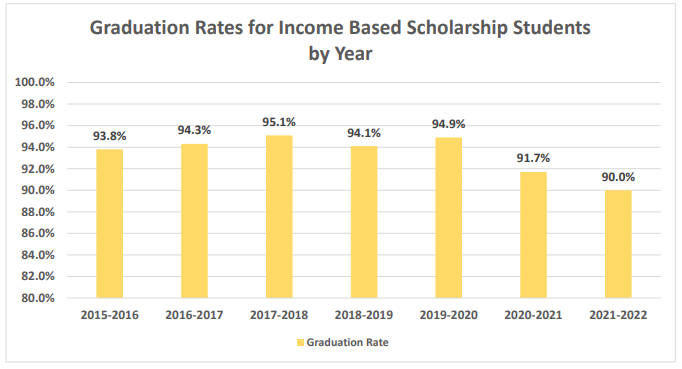
The graduation portion of the report was modeled after the National Center for Education Statistics’ biennial report, “Characteristics of Private Schools in the United States: Results from the 2019-2020 Private School Universe Survey.”
Data from the Florida Department of Education were utilized to examine these private schools along with data collected by Step Up For Students through school surveys. Data on religious affiliation were collected at the school level. Information about students’ gender, race/ethnicity, grade, single parent household status, poverty level, and graduation status were collected at the student level.
The survey received a 92.4% response rate.
*Edited to clarify that part of the growth in scholarships awarded by Step Up For Students was due to administrative changes in the FES-EO scholarship.
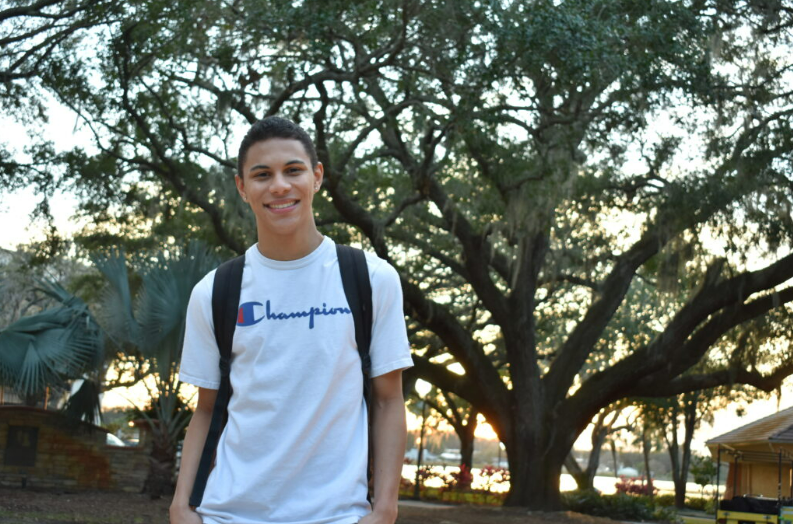
Jaylen Arnold, 22, has spoken to more than 300,000 students in 38 states and the United Kingdom and has educated many more online about Tourette Syndrome.
LAKELAND, FLA – Jaylen Arnold was 8 when he walked into his old elementary school to speak with two dozen or so former classmates, many of whom had recently taunted and physically bullied him.
Jaylen was scared. His mother, Robin, walking beside him, was proud.
The meeting was Jaylen’s idea. He wanted to explain what others saw as his unusual life.
Jaylen has Tourette Syndrome, a neurological disorder that causes sudden unwanted and uncontrolled rapid and repeated movements or vocal sounds called tics. He was an easy target, and the abuse from his peers sent his tics into overdrive.
He was classified as hospital homebound by his doctor and Robin removed him from the school.
Jaylen, now a senior at Southeastern University in Lakeland, has been an advocate for those with Tourette Syndrome and those who have been bullied for the last 14 years.
An education choice scholarship was about to change Jaylen’s life for the better.
It allowed him to attend a private school near his Lakeland home. There, Jaylen found schoolmates who looked past his Tourette’s, autism and obsessive-compulsive disorder and saw a likeable, intelligent and talented friend.
“He was accepted and loved,” Robin said.
It was acceptance and, if not love, at least tolerance that Jaylen wanted for others when he returned that day 14 years ago to his old school and met with his old classmates. He wanted to teach them about Tourette’s, hoping education would lead to understanding and that would reduce the bullying if not remove it completely.
“I wanted to go back and educate those who were tormenting me because who knows what kind of chain reaction that could have,” Jaylen, now 22, said.
There was a chain reaction, and it was nothing Jaylen or his mom envisioned.
To continue reading, click here.

Aimee Uriarte and her two sons, 15-year-old Alejandro, left, and 17-year-old Sebastian, right.
On this episode, reimaginED senior writer Lisa Buie talks with Aimée Uriarte, a single parent whose two sons attend Christopher Columbus High School, an all-male Catholic school in Miami.
 Older son Sebastian, 17, receives a Family Empowerment Scholarship for Educational Options, while his brother, Alejandro, 15, attends on a Family Empowerment Scholarship for students with Unique Abilities.
Older son Sebastian, 17, receives a Family Empowerment Scholarship for Educational Options, while his brother, Alejandro, 15, attends on a Family Empowerment Scholarship for students with Unique Abilities.
A Costa Rica native, Uriarte moved to the United States but left in 2008 due to the Great Recession. One of the reasons she returned to Florida was to ensure her children received opportunities for an education that best fit their needs. Columbus High fills that bill and more, she said.
Uriarte, who was among the scholarship beneficiaries who spoke during the recent signing ceremony for HB1, a major education choice expansion bill, said she looks forward to the additional flexibility the legislation will bring to her family and others.
“The Columbus staff has come through, truly as a family, I never expected this compassion regarding our family's reality. Every family has different struggles … they are very hands on, all of them, and they’re very concerned about the wellbeing of each family.”
EPISODE DETAILS:
RELEVANT LINKS:
https://www.fldoe.org/schools/school-choice/k-12-scholarship-programs/fes/
 Editor’s note: This opinion piece from William Mattox, director of the J. Stanley Marshall Center for Educational Options at The James Madison Institute and a reimaginED guest blogger, appeared Monday on floridapolitics.com.
Editor’s note: This opinion piece from William Mattox, director of the J. Stanley Marshall Center for Educational Options at The James Madison Institute and a reimaginED guest blogger, appeared Monday on floridapolitics.com.
At a Miami education conference several years ago, I heard a comment every Florida legislator ought to hear — perhaps especially now that the House and Senate are wrangling over differences in their respective budgets.
The comment came from an anti-poverty expert from another state who had carefully studied Florida’s school choice policies. While he supported Florida’s K-12 scholarships for low-income students, he nevertheless argued for universal coverage for all families (regardless of income).
“Even if one is only concerned about helping the poor, universal is the way to go,” the anti-poverty advocate said. “Because universal coverage means the scholarships low-income children so desperately need will be broadly supported and widely usable.”
I was reminded of this counterintuitive observation recently when the House passed a budget that included changes to the Florida Education Funding Program (FEFP) formula. The changes read like the arcane fine print in a financial disclosure agreement, but they have important implications for Florida’s newly adopted universal K-12 scholarships.
Here’s why.
Under the House budget, all Florida families would be guaranteed funding for a K-12 scholarship just as they are guaranteed free public schooling. Under the Senate’s proposed budget, newly eligible families would only receive K-12 scholarships if there’s enough money available.
That description of the Senate’s plan probably sounds more ominous than it should. Because the Legislature has consistently increased scholarship funding any time a waiting list develops so that families aren’t denied help for years on end.
Still, there’s reason to strongly favor the House’s guaranteed-scholarship plan because it brings to the K-12 education marketplace something that has been sorely missing — certainty.
To continue reading, click here.

St. Raymond of Penafort Catholic School in Philadelphia is one of 2,417 private schools in Pennsylvania serving more than 284,000 students. Its vision is that students will leave eighth grade emotionally and spiritually formed by Catholic example, performing at or above grade level, and enrolled in an academically rigorous high school program.
Editor’s note: This article appeared last week on the philadelphiacitizen.org.
When Tammie Tilson was growing up in Mt. Airy, her father insisted she attend a private Catholic school through eighth grade. After that, she could choose if she wanted to go to a public or private high school.
She chose public. More than a decade later, she still questions that decision. In some classes, books were in short supply, requiring students to share. A college-prep math course began with concepts she’d learned years earlier. Her new classmates seemed more likely to disrespect teachers and fight in class than her old schoolmates.
Now a parent, Tilson said that experience, combined with her strong faith, are the primary reasons she wanted her three children to attend Catholic schools. She and her husband wouldn’t be able to afford that without yearly financial support from the non-profit Children’s Scholarship Fund Philadelphia.
“A lot of people say, ‘I can’t afford Catholic school,’” says Tilson, whose three children attend St. Raymond of Penafort Catholic School. “I say, ‘Me either. But I am here. Let me tell you how. ‘”
CSFP is about school choice, but not the type of school choice that’s in the news again after Florida Gov. Ron DeSantis last week signed a universal school choice law. CSFP exists to help families who want to send their kids to private schools but won’t be able to do so without financial assistance. It’s funded by two state tax credit programs.
“We try to stay in the lane of helping families who raise their hand and say, ‘I want something different.’ Right now, I don’t see my neighborhood school as an option for my child,” CSFP President/CEO Keisha Jordan says. “We support families who, without us, would have no other option.”
To continue reading, click here.
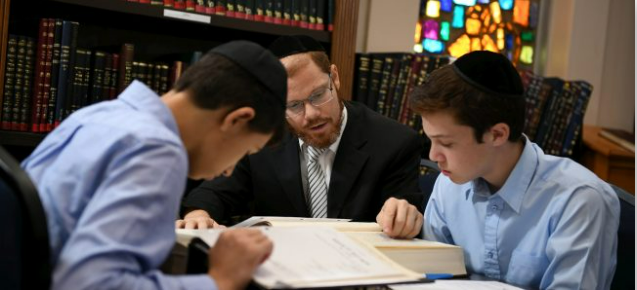
Students from junior pre-K through high school at Yeshiva Toras Chaim Toras Emes in North Miami Beach, Florida, receive education in Limudei Kodesh in conjunction with a rigorous secular studies program that focuses on building strong minds and strong characters in a warm, welcoming learning environment. Lessons are tailored to each student’s unique learning style and needs.
Editor’s note: This article appeared Tuesday on ou.org, the website of the Orthodox Union. You can read a story about Jewish day schools and education choice from reimaginED senior writer Lisa Buie here.
Leaders from six Jewish day schools in South Florida recently convened to discuss the historic school choice expansion that Gov. Ron DeSantis signed into law on March 27. The new law expands scholarships to all K-12 students in the state and will give approximately $8,000 per student.
This could bring as much as $40 million of new funds into Jewish day schools, which will help alleviate South Florida families who are struggling with the private school tuition crisis. One concern shared by many parents is that the influx of these funds will cause schools to raise tuition by $8,000, which would negate the affordability factor.
To address this issue, representatives from Jewish day schools met in a small focus group with staff members and the executive committee from Teach Florida, a project of the Orthodox Union, the nation’s largest Orthodox Jewish umbrella organization. The schools strongly affirmed that affordability is a critical component of their educational mission and will remain a key focus for them moving forward.
“Affordability is an important value of our schools,” says Teach Florida Engagement Director Melissa Glaser. “They don’t intend to take the state funds and then turn around and increase tuition by an equivalent amount. The schools recognize the value of affordability, and their goal is to support families receiving much-needed relief funds toward tuition, while providing a quality education to their students.”
Rabbi Bernstein of Toras Emes agrees, and says, “Over the last decade, we raised tuition very minimally as we value affordable education for our families. This year, before learning of the school choice bill, we made the decision to raise tuition due to incredible hiring challenges and inflationary costs.”
He adds, “We fully support the fact that school choice funds are intended as a relief for parents and will not be viewed as extra entitlement for the school.”
To continue reading, click here.

Lilly Bowden of Plant City, who is homeschooled by her mother, Debbie, receives funding for school supplies, including a computer and printer, books, a telescope and a microscope, through Florida’s Family Empowerment Scholarship for Students with Unique Abilities.
PLANT CITY – Lilly Bowden flipped through her sketch pad and proudly showed off her work. There’s a fox on one page and a cat on another. A giraffe from the neck up and a mountain range in all its purple majesty.
One drawing begins on one side of a page and ends on the other, forming a U-shape. A snake? An eel?
“I have no idea what that is,” Lilly said.
More pages, more drawings. An armadillo. A seahorse. A seashell. A leaf. One page has a pineapple, a watermelon, and some grapes.
“It’s a still life,” Lilly said. “Kind of abstract.”
Lilly, 12, wants to be an artist, and she’s taking her first steps with the “Drawing Lessons for Beginners” DVD purchased with her education savings account that comes with the Family Empowerment Scholarship for Students with Unique Abilities. Managed by Step Up For Students, (which hosts this blog) the ESA gives parents the ability to customize their child’s educational needs.
The money can be used for curriculum and education materials, therapies and medical specialists, tutors, and tuition to private schools.
“The scholarship has been such a blessing for us,” said Debbie Bowden, Lilly’s grandmother and legal guardian.
Lilly was born with pulmonary atresia with ventricular septal defect, a congenital heart disease that left her with one working ventricle. She’s had three reconstructive heart surgeries, one each year for three years beginning when she was 1.
When she was 5, a blood clot led to a stroke, which led to the diminished use of her right arm and hand.
She has a pacemaker. She has scoliosis and wears a back brace 20 hours a day. She has several allergies.
Because of Lily’s weakened heart, a minor cold can turn into pneumonia and land her in a hospital for two weeks. A growth spurt could place too much stress on her heart and prove deadly, Debbie said.
“With Lilly, we take it one day at a time. For everything that’s she’s got, she’s still a fighter. She’s lived a lot longer than they ever thought she would,” Debbie said.
To continue reading, click here.
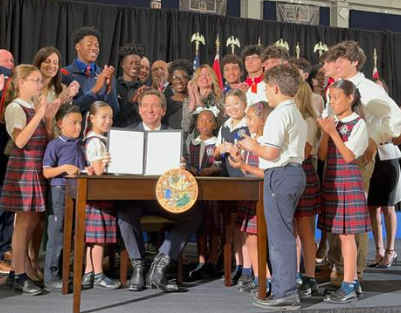 Editor’s note: This article appeared Monday on floridadaily.com.
Editor’s note: This article appeared Monday on floridadaily.com.
With the signing of a universal school choice bill last week, Gov. Ron DeSantis and the state are receiving praise from school choice advocacy groups.
“This legislation is nothing short of transformational,” said Danny Aqua, executive director of Teach Florida. “Every student in Florida will soon have the opportunity to experience an education that works for them thanks to Gov. Ron DeSantis.”
In a legislative session loaded with major policy proposals, one focal point has been a school choice proposal that would expand eligibility for scholarships to all K-12 students in Florida.
DeSantis signed the bill into law last week, which creates one of the largest expansions of school choice in the country. The legislation was also a top priority of Florida House Speaker Paul Renner, R-Palm Coast.
“The state of Florida is number one when it comes to education freedom and education choice,” said DeSantis at the bill signing. “Today’s bill signing cements us in that number one position. We’ll be signing legislation that represents the largest expansion of education choice, not only in the history of this state, but in the history of these United States.”
Under the new law, education funding will directly benefit families in the form of Education Savings Accounts that will provide opportunities for Florida students to attend a school of their choice. The money will be used as parents see fit to further their children’s education, such as for public, private, charter, or magnet schools, whether online, in-person, or a hybrid of the two.
Critics of the proposal argue that this legislation will divert resources away from public schools and toward private schools. However, supporters of the legislation assert that funding will now follow the student.
To continue reading, click here.
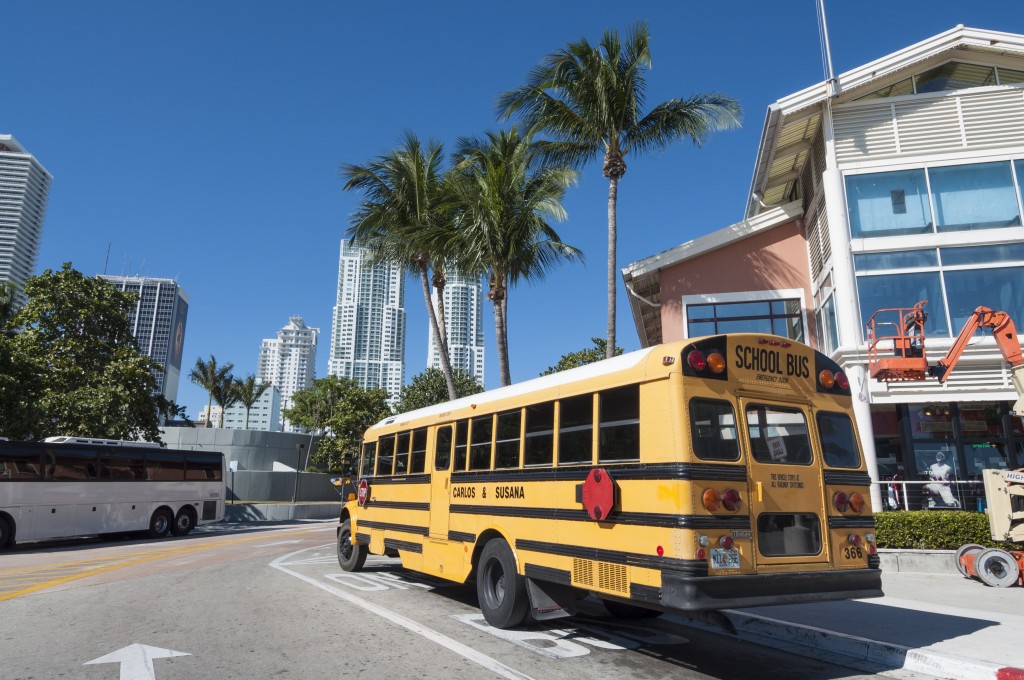 Editor’s note: This analysis from Patrick Gibbons, manager for Policy and Public Affairs at Step Up For Students, is the second in a two-part series. You can read Part 1 here.
Editor’s note: This analysis from Patrick Gibbons, manager for Policy and Public Affairs at Step Up For Students, is the second in a two-part series. You can read Part 1 here.
Earlier this month, the Southern Poverty Law Center, Education Law Center, Public School Funds, and the National Center for the Study of Privatization in Education teamed up to publish a report titled “The Fiscal Consequences of Private School Vouchers.”
The report concludes that vouchers have resulted in a decline in per-pupil funding to K-12 schools in the states where vouchers are active.
The analysis makes several flawed assumptions to reach those conclusions:
The SPLC report states “the decline in per-pupil funding in Florida cannot be attributed to economic duress.” The report blames vouchers instead.
Perhaps the SPLC forgot about the housing market crash.
Like many states, Florida uses property taxes to help fund K-12 education. Florida’s red-hot housing market popped in 2006 with a global housing market crash. Despite the bankruptcies and collapsing housing values, Florida’s K-12 school system saw record-high per pupil spending in 2008.

*Data from the U.S. Department of Education’s Digest of Education Statistics and adjusted
to 2020 dollar values with the U.S. Bureau of Labor Statistics inflation calculator
After several years of inflated spending, it was clear those levels were not sustainable. Per-pupil funding then declined to the same inflation-adjusted amount as in 2006.
Worse still, Florida’s first voucher came about in 1999 with fewer than 100 students. Today, there are more than 250,000 tax credit scholarship, voucher, and education savings account students in the state. Despite this, public school funding is actually up $1,331 per pupil since 1999-2000.
If that was not enough damage to the SLPC argument that vouchers, not economic challenges, are to blame, consider the fact that Florida’s per capita income cratered and never recovered as of 2019.
Per capita real Gross Domestic Product of Florida 2008-2019
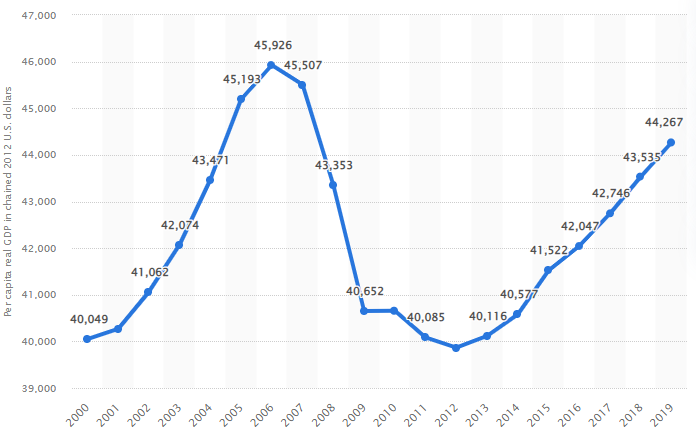
*Source: Florida: per capita real GDP 2000-2019 | Statista
It’s also worth noting the SLPC’s and Education Law Center’s obsession with “spending effort” – which is really just spending as a percentage of the state’s gross domestic product – is useless.
Imagine defining your personal housing success as increasing your housing expenses as fast or faster than your wages, regardless of whether the quality of your housing actually improved.
In fact, there doesn’t appear to be any correlation with “spending effort” and education quality as defined by the most recent Education Week’s Quality Count’s K-12 Achievement rankings.
States in the Top 10 for “spending effort” spent $18,169 per pupil on average and averaged a C-minus with a score of 72.43 on Education Week’s achievement ranking.
States in the Bottom 10 for “spending effort” spent $9,871 per pupil and averaged a C-minus with a score of 73.14.
Those high-effort states spend twice as much to get roughly the same result (albeit ever so slightly worse).